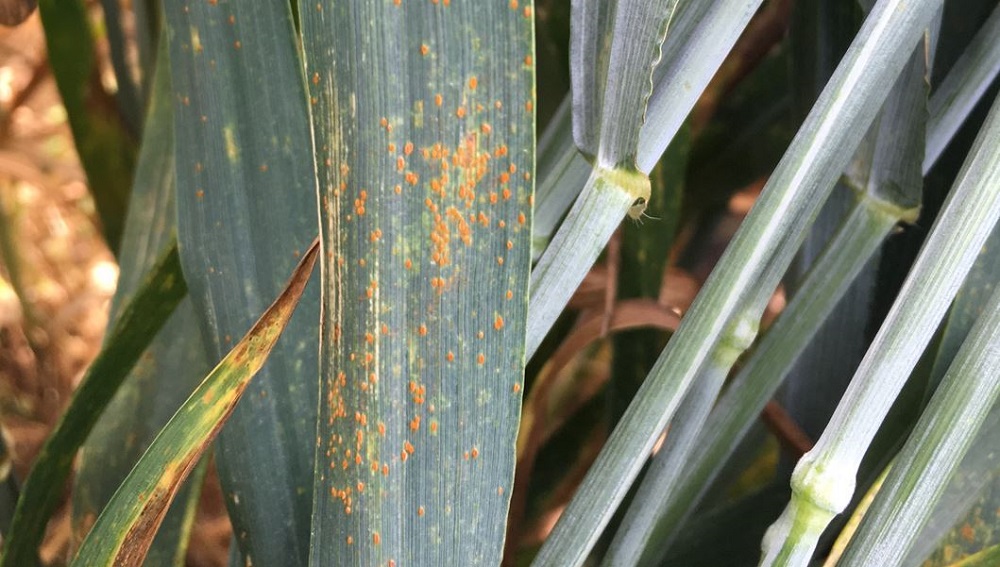Use fungicide performance information to battle wheat brown rust
Thursday, 16 May 2024
High levels of brown rust are appearing early in some AHDB Recommended Lists (RL) winter wheat trials and commercial crops.
Farmers should look up the RL disease ratings of their varieties, monitor crops and use AHDB fungicide efficacy data to manage the disease.
AHDB Senior Crop Production Scientist Mark Bollebakker, who oversees the RL trials, said:
“Most varieties on the RL only show a moderate level of resistance to brown rust and a few are quite susceptible. The early infection and susceptibility of varieties means we need to prepare for an outbreak, should conditions remain conducive to the disease.”
There is always a large seasonal and geographic variation in brown rust severity. Outbreaks typically occur when the temperature climbs above 15˚C to 25˚C. As a result, the disease tends to be seen more in southern and eastern parts of the UK. However, disease pressure may be higher than average over much of the UK this year.
Once established, the disease can cycle very rapidly in favourable conditions, with symptoms appearing only five to six days after infection.
Typically, the disease peaks in midsummer. It is unusual to see the disease at this level this early in the season, with low levels of infection even recorded in March at RL trial sites. The relatively mild winter is likely to have encouraged disease development.
Brown rust symptoms
.JPG) NIAB
NIAB
Farmers should look out for small pustules on the leaf surface, which are usually less than 1 mm in diameter. Unlike yellow rust, brown rust pustules do not develop in lines along the length of the leaf.
The winter wheat in the image above shows classic brown rust symptoms (leaf 3). The photo was taken recently at one of our fungicide performance trial sites (the variety has a disease rating of 5).
Rust-active fungicides
AHDB Head of Farming Systems and Agronomy Ollie Johnson said:
“This season, farmers should consider increasing their use of rust-active fungicides at the T2 timing to counter the threat, especially on relatively susceptible varieties. T2 is the most economically important spray, so a lot rests on it.
AHDB fungicide performance work details the relative performance of key fungicides against brown rust and other foliar pathogens of cereals. The results can help farmers target brown rust, as well as the other main diseases at this timing, such as septoria tritici and yellow rust.”
To maximise differences between treatments for each target disease, the fungicide performance cereal trials use high-risk locations, highly susceptible varieties and one spray timing (T2 for brown rust trials). As a result, the trials provide a tough test for fungicides. The trials also test mixtures and straights. In commercial situations, fungicides should be used in mixtures.
The fungicide performance curves for brown rust, which show strong uplifts in disease control and yields associated with treatment, are available to view on slides 19 and 20 of the latest fungicide performance presentation, in the fungicide performance video or on ahdb.org.uk/fungicide-performance
Based on three fungicide performance trials over three seasons (2021 to 2023), products that contain isoflucypram or mefentrifluconazole have been shown to be highly active against brown rust, with useful activity from pydiflumetofen.
The fungicide performance team also publishes fungicide activity ratings for a wider range of active ingredients, which uses a 1-to-5 scale (where 5 = highest control level).
For example, this shows that the inclusion older rust-active chemistry in tank mixes, such as tebuconazole and some strobilurins, can still provide useful activity.
Information on young plant resistance to brown rust and how to submit a sample for testing by the UK Cereal Pathogen Virulence Survey (UKCPVS) is detailed in a recent news item.
The pathogen that causes brown rust in wheat (Puccinia triticina) is specific to wheat and will not infect other cereal crops, including barley, rye and triticale. Different (related) pathogens cause brown rust in other cereals.




